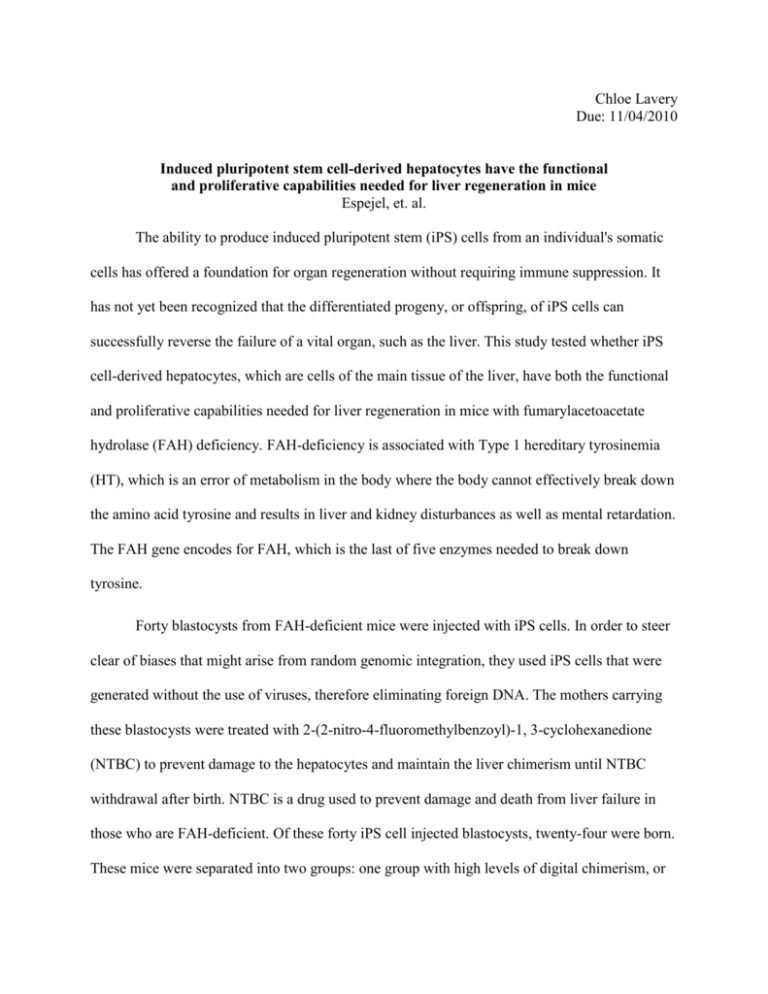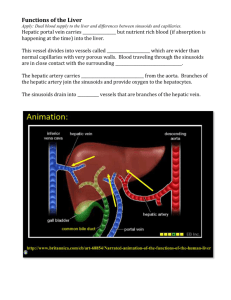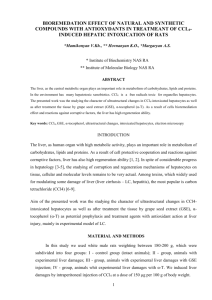Scientific_Paper_Summary
advertisement

Chloe Lavery Due: 11/04/2010 Induced pluripotent stem cell-derived hepatocytes have the functional and proliferative capabilities needed for liver regeneration in mice Espejel, et. al. The ability to produce induced pluripotent stem (iPS) cells from an individual's somatic cells has offered a foundation for organ regeneration without requiring immune suppression. It has not yet been recognized that the differentiated progeny, or offspring, of iPS cells can successfully reverse the failure of a vital organ, such as the liver. This study tested whether iPS cell-derived hepatocytes, which are cells of the main tissue of the liver, have both the functional and proliferative capabilities needed for liver regeneration in mice with fumarylacetoacetate hydrolase (FAH) deficiency. FAH-deficiency is associated with Type 1 hereditary tyrosinemia (HT), which is an error of metabolism in the body where the body cannot effectively break down the amino acid tyrosine and results in liver and kidney disturbances as well as mental retardation. The FAH gene encodes for FAH, which is the last of five enzymes needed to break down tyrosine. Forty blastocysts from FAH-deficient mice were injected with iPS cells. In order to steer clear of biases that might arise from random genomic integration, they used iPS cells that were generated without the use of viruses, therefore eliminating foreign DNA. The mothers carrying these blastocysts were treated with 2-(2-nitro-4-fluoromethylbenzoyl)-1, 3-cyclohexanedione (NTBC) to prevent damage to the hepatocytes and maintain the liver chimerism until NTBC withdrawal after birth. NTBC is a drug used to prevent damage and death from liver failure in those who are FAH-deficient. Of these forty iPS cell injected blastocysts, twenty-four were born. These mice were separated into two groups: one group with high levels of digital chimerism, or high contribution of iPS cells to genomic DNA from digits, and the other group consisted of those with no/low levels of digital chimerism. The six mice with high levels of digital chimerism continued to thrive in the absence of NTBC while the remaining eighteen lost weight and NTBC treatment had to be restored to prevent death. The mice born from the FAH-deficient blastocysts not injected with iPS cells quickly deteriorate and needed rescue from liver failure with NTBC. There was no evidence of the FAH gene or protein expression in the mice with no/low levels of digital chimerism. In the mice with high levels of digital chimerism, there was levels of liver repopulation ranging from 50%-100%. Also, they had FAH expression levels in the hepatocytes that were approximately 80% of the FAH expression levels in wild-type mice. The FAH-expression levels were similar to the expression levels in hepatocytes derived from embryonic stem cells. In these high level mice, liver function tests continued to be normal after ten months of NTBC withdrawal. The livers that regenerated approximately 100% of hepatocytes were challenged with a two-thirds partial hepatectomy, a removal of part of the liver through surgery. These mice were able to tolerate the operation normally and survive long-term. In vivo analysis showed that iPS cells were able to differentiate into fully mature hepatocytes that supplied full liver function. The iPS cell-derived hepatocytes also simulated the unique proliferative ability of normal hepatocytes and were able to regenerate the liver after transplantation and a two-thirds partial hepatectomy. This study established the possibility of using iPS cells generated in a clinically suitable manner for quick and stable liver regeneration. Not only could this study pave way for organ therapies absent of immune suppression, but it proves that iPS cells can be used and suggests that iPS cells are just as effective as embryonic stem cells in regeneration.









